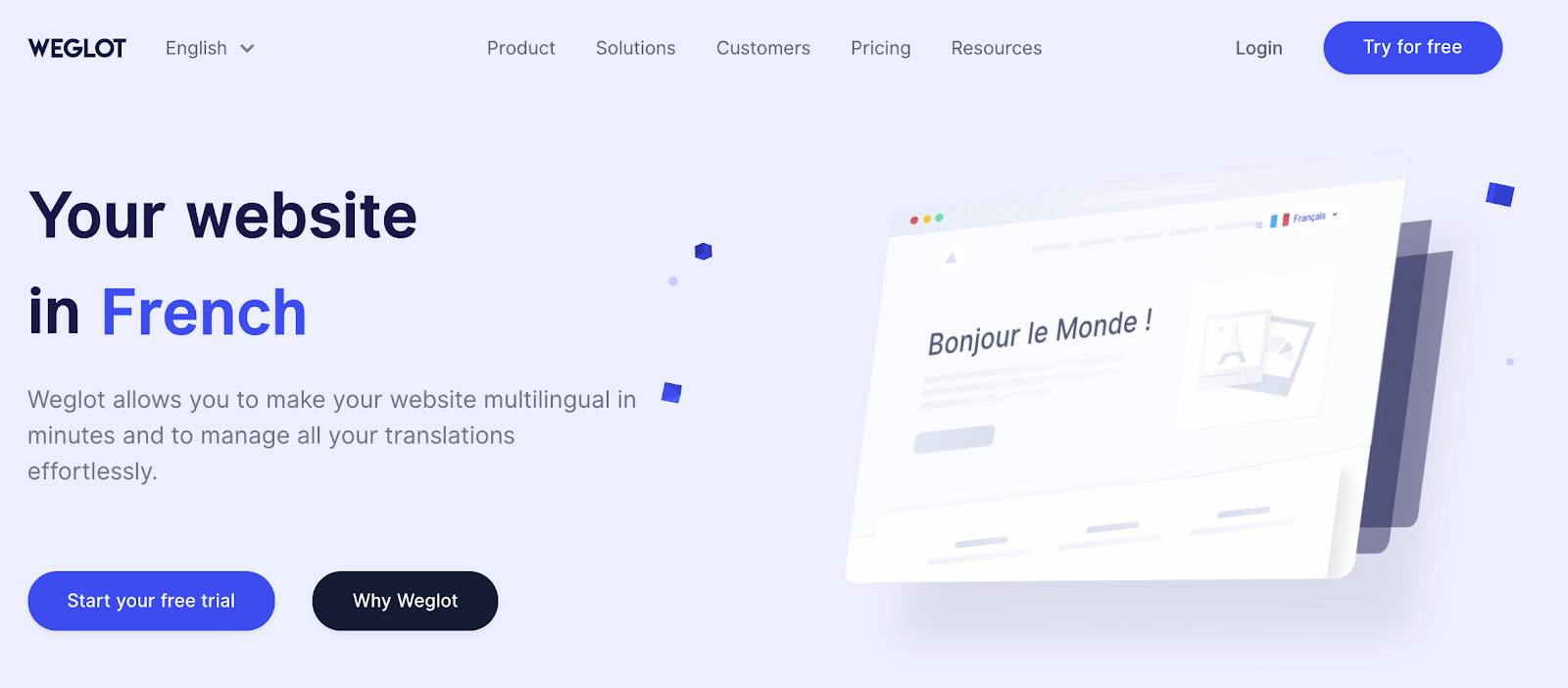Online learning has exploded in popularity over the past few years. This is understandable given how the internet is present in our daily lives. However, because the net is global, making your course multilingual should be a top priority. If you’re not a speaker of other languages, this could post a problem when trying to find new enrollees.
However, you don’t have to be a multilingual speaker. Robust learning experience management systems like Thinkific can integrate with translation solutions like Weglot to translate your course and website to take your training worldwide quickly and reliably.
In this article, we’ll take a look at some options to translate your online course. Before this, let’s talk more about why making your course multilingual is a good idea, and some pitfalls to avoid.
Why you’d want to translate your online course
There are many reasons why you’d want to translate your online course. Here are just a few of the major ones:
- You can take your online learning business international
- You could use your online course as a training program for multinational organizations
- You can let students learn in a language that’s comfortable to them
Let’s touch on some of these points further. Of course, the web is global by design. However, this doesn’t mean you’re able to market your course to everyone on the planet. Of course, language will be a barrier. However, if you look at the statistics, 50–60 percent of the web uses English as its primary language.
 Source: Statista
Source: Statista
This makes a compelling counter-argument. If nearly two-thirds of the web converse in English, why would you need to translate your course?
The reason is the other 40 percent.
While not everyone in this ‘slice’ will lack English skills, it shows that people are more comfortable consuming content in their native language.
As such, translating your course into Russian and Spanish could capture another 10–15 percent of learners.
This is a solid increase, so in our opinion, it’s worthwhile to make your course multilingual.
Common translation pitfalls you’ll encounter (and how to overcome them)
At this point, you may understand why translating your online course is a good idea, and are eager to get started. However, it’s also a good idea to consider some of the roadblocks that stand between you and a perfectly translated and multilingual site.
There are three major pitfalls you’ll want to watch out for:
- Confusing and poorly-translated content
- Making sure you have support in place for your translated languages
- Challenges with regard to international Search Engine Optimization (SEO)
While we’ll discuss the first pitfall in more detail later, the solution is to use a dedicated translation service. It will offer the knowledge and expertise to help make your site multilingual.
It may be easy to translate your course, but what about support?
When it comes to supporting your students, there are two approaches you can take.
Multilingual support
First, you may be able to offer dedicated support for each language. However, this could hit your budget hard for more than a handful of extra languages.
Service language disclaimer
Alternatively, you could have a disclaimer. This would state that while your course is in the user’s primary language, support will always be in English. However, this isn’t user-friendly and could cause more headaches if learners need extra help. Once again, there is a better solution available than either of these options.
Finally, your SEO is vital for the success of your course, as is accessibility. To help, hreflang tags within your site’s HTML code tell search engines which language you’re using on a page. When a learner accesses your site, the tag looks at their IP address and serves a page in a language based on their location.

However, they are incredibly difficult to implement if you’re not a developer and it’s not the only basis to getting indexed by international search engines. Overall, using hreflang tags with other multilingual SEO best practices is good for search engines.
How to translate your online course (3 options)
There are two options you might consider when translating an online course. However, they have their own positives and negatives. We’ll discuss these two options, and introduce a third. This will offer the best of both worlds while supercharging the way you offer multilingual courses. Let’s take a look!
1. Use a machine translation service
Anyone who used the internet back in the 90s and early 2000s will remember Babelfish. It is an online tool that takes your words and translates them into a chosen target language. However, Babelfish wasn’t designed as a robust professional translation service. Now, machine translation sites such as Google Translate and Bing’s Translator are Babelfish reimagined:

Even Apple has its own app. However, while they are all quick and user-friendly, there are still drawbacks of these types of services:
- You’ll need to manually copy the original text into your chosen tool. Depending on the amount of content you need to translate, this could take a long time
- Once you have translated the content, you’ll need to paste it into your site. Again, this can be time-consuming for you and will involve creating a whole new set of pages and/or courses
- As we’ve alluded to, the quality of translation could be mediocre for complex sentences. This is going to erode your authority and professionalism, especially if you want to offer stellar learning to students
In reality, you aren’t going to rely on machine translations to create a multilingual online course.
However, our second option is going to be on your radar.
2. Hire a professional translator
Next, you could hire a professional translator. On the surface, this is a logical solution to a complex problem, for the following reasons:
- They will be able to dedicate the most time to each translation you ask for
- A translator can meet your exact requirements on a page-by-page basis. This makes for highly-accurate translations
- They can offer extra input to your translations where necessary. This is good news if you don’t have knowledge of the second language
However, with these benefits come a few drawbacks:
- Cost – A professional will charge a price worthy of their services. This could cut into your budget more than necessary, or even be out of your price range altogether
- Time – It’s time-consuming in a different way to using machine translation. Ultimately, the process is long-winded, given that you need to pass content to the translator and wait while they carry the conversion out
- Updates – You can multiply the time and cost based on how many times you update your course. For every update you carry out, you’ll need to book time with your translator, pay the rate they’ve set, and wait for delivery
Even given the negatives, hiring a translator is a solid-option – much better than relying on machine learning. However, because of the cost, it’s going to be out of reach for all but the most affluent site owners.
3. Activate Thinkific’s Weglot integration for hassle-free full-site translation
There are two factors in running a multilingual online course. The first is finding a suitable eLearning platform. The second is choosing the right translation service. Of course, we recommend Thinkific for creating, marketing, and selling an online course:

The great thing about Thinkific is how customizable it is – if we haven’t built it, we’ll integrate with someone who has!

There are many benefits of combining both solutions:
- You get to leverage a robust and powerful learning platform with a stellar translation service
- Both solutions are cost-effective
- Weglot and Thinkific fit the needs of someone offering online courses, and multilingual content
- Weglot is able to translate everything within the Thinkific Content Management System (CMS). This means you can offer site-wide translated content. What’s more, your support will also be in a language comfortable for the learner
- Weglot is multilingual SEO ready – language-specific subdomains, automatically added hreflang tags and translated metadata
If you’re wondering how smooth it is to integrate Weglot with your Thinkific site, there are four steps to take:
- Sign up for a Weglot account
- Add your domain name, original language, and target language to your account
- Configure your site’s DNS records to connect to your translation subdomains
- Copy and paste a few lines of JavaScript into your Thinkific site’s code
Once you save your changes, your site and courses will be fully translated and ready to use! Check out Weglot and Thinkific in action.

The way Weglot works is by detecting all the content on your Thinkific website (including your online courses), translating it with the first layer of machine translation, and then displaying the content under language-specific subdomains. So, you don’t need to duplicate pages or websites to display multiple language versions.
You’ll get a language switcher added to your website so your website visitors can switch between their language of choice.
If you’re interested in finding out what Weglot has to offer, there’s a free 10-day trial available with no obligation to purchase. Paid plans start from €9.90 ($11.99) per month depending on your needs.
Conclusion
Translating your courses for speakers of other languages can seem like a pipe dream on paper. However, it’s more straightforward than you think. In fact, if you can mitigate the potential pitfalls by using a tool such as Weglot, you have a clear path for creating a multilingual online course.
This post has looked at three ways to translate your online course. Let’s recap the options:
- Translate your content using a site such as Google Translate. However, you’ll have more work to do in order to make translations more accurate and to upload them to your site
- Use a professional translator, although you may need to spend extra time and money on translations in the future
- Opt for a solution such as Weglot, and integrate with Thinkific. This lets you create, market, and sell online courses with stellar translations into more than 100 languages
Do you think a multilingual course can benefit your business, and if so how? Let us know in our Facebook group for online course creators!






